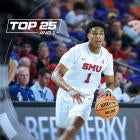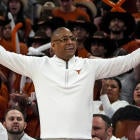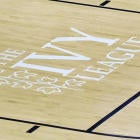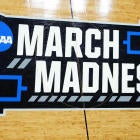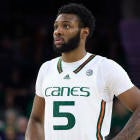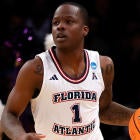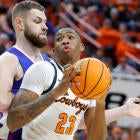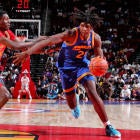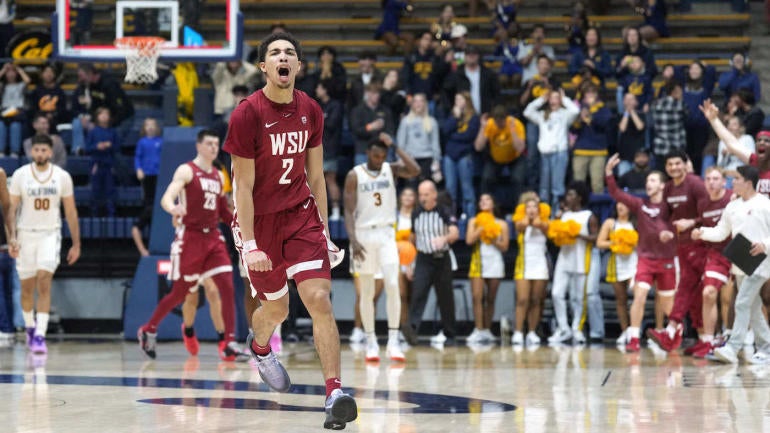
A player overcoming cancer to lead his school to its first NCAA Tournament in 16 years. That's what is playing out in the Palouse, where Washington State freshman guard Myles Rice is the main feature to one of the best stories of the season.
Washington State — a program with paltry NCAA Tournament participation dating back to 1941; just six appearances, second-fewest among power conferences to Northwestern's two — is 18-6 and sits in second place in the Pac-12 after being picked 10th in the preseason. The Cougars project in the 7-seed range for now. Kyle Smith is pulling off a mini miracle, particularly when you consider all of the immense forces that have worked against Wazzu since last year, when the program was stranded alongside Oregon State as the rest of the Pac-12 membership fled for the Big Ten and Big 12.
Washington State has been toiling for nearly a generation. It has the second-longest NCAA Tournament drought of any power-conference program (DePaul has the longest), but is moving closer and closer to making its first March Madness appearance since 2008. Wazzu is thriving despite losing three crucial players: Mouhamed Gueye to the NBA; DJ Rodman to USC; and TJ Bamba to Villanova.
Who's made up for that loss? More than anyone, it's been Rice, the spiritual and statistical centerpiece to Washington State's reawakening.
"Being able to be a part of this team, and doing something that hasn't been done in a long time, is everything that a kid could dream for honestly," Rice told CBS Sports.
Rice is coming off his third straight Pac-12 Freshman of the Week honor after scoring 21 points and snagging a career-high nine rebounds in a 62-56 win at Oregon. He's the only freshman at a high-major program leading his team in scoring (15.6 ppg), assists (3.8 assists) and steals (1.8).
"It's an honor to be able to share my story," Rice said.
What a story it is.
This is Rice's third year of college but his first season on the court. A three-star prospect out of Covington, Georgia, Rice was a COVID-era recruit. Most programs who offered Rice a scholarship never saw him play in person. Washington State was the only school from a high-major conference to give Rice an offer — and it was 2,000 miles and three time zones away.
The staff took a chance on him, so Rice believed he should take that same chance on them. That was enough. In the late summer of 2020, Rice committed.
It would be more than three years before he played for the Cougars.
Rice redshirted for his 2021-22 freshman season due in part to portal additions and veteran experience. How often is someone willing to play 2,000 miles from home and sit out his first college season?
"I kind of pushed back a little bit because I didn't want to accept it in that moment of time," Rice said. "But as time went on, I kind of changed my mindset."
Rice got better over the course of eight months and was progressing toward being a big contributor for the 2022-23 season. Then, in the summer of 2022 while visiting his dad's side of the family in South Carolina, one of Rice's relatives noticed swelling on Rice's neck. He thought it was a result of excessive weightlifting or stress from basketball training. The swelling didn't subside, so soon enough Rice had it examined in Atlanta. Doctors there ordered a biopsy for the swelling when Rice returned to Pullman.
It was Hodgkin's lymphoma.
Washington State's athletic trainer broke the news to Rice on Sept. 12, 2022 — his mother Tamara's birthday. Rice wanted to resist this new reality. He cried. He called his mom reluctantly, not wanting to spoil her day.
"When you get cancer, you're gonna think one of two things, either the good or the bad," Rice said.
His parents kept him in the good. He didn't know how to handle it, but he knew how to lean on Mom and Dad, even from afar. Tamara Rice moved to Pullman. Thankfully, the cancer was treatable, detected early (Stage 1) and a full recovery was a realistic objective from the outset. But it also meant Rice would sit a second straight season.
The most important message from the doctors: time heals all.
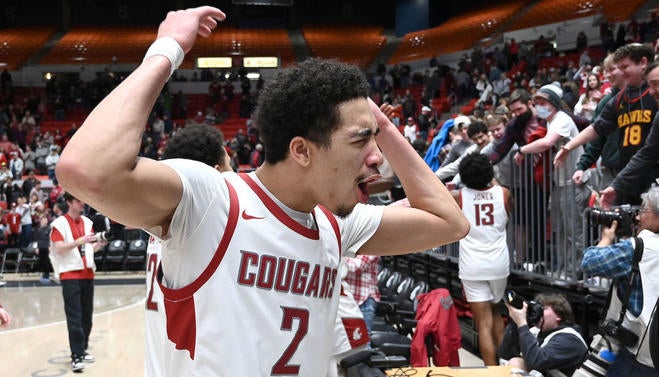
Rice underwent twice-a-month chemotherapy treatments from October 2022 through March 2023, with each round lasting nearly five hours. The first few trips zapped him; he was sleeping as much as 15 hours a day. By his second month, Rice was developing a bond with the doctors and nurses. Instead of watching movies or TV shows, he held hours-long conversations. They became a secondary family for Myles.
"We were able to just create a nice little nice little bond," he said. "I'm just beyond grateful that I was here with this community, with this coaching staff, with my teammates and having my family by my side through everything."
Even as he went through treatments, Rice couldn't help himself from sneaking into the gym and getting up shots. He couldn't even hide it from the coaching staff.
"It was probably not the best idea at the time, but I gotta say, I love the game so much. I was trying to sneak into the gym any moment that I could," Rice said.
He also didn't miss class. Mom wasn't having any of that. It was nothing but As and Bs for Rice — and a GPA that's still cruising above 3.0.
On March 9, 2023, Rice made the short drive over the Idaho border for his final chemotherapy treatment. Less than three months later, on June 1, as he enjoyed an afternoon on the golf course with his father Joel, he got the call.
The cancer was officially in remission.
The best was yet to come — beyond everyone's expectations. Rice was outstanding all summer and into the preseason. But to be in contention for Pac-12 Freshman of the Year and lifting Washington State to rarely seen heights amounts to one of the most shocking 2024 plot twists in American sports.
"I just want to give a shout out to all my teammates, my coaches, they believe in me so much, you know, that even sometimes when I might have a little bit of doubt, they remind me that we believe in you," Rice said.
Going through a cancer battle built Rice into a better competitor, but talk to him and you'll see he's not hardened by the experience. His personality isn't cut from redemption narratives or defined in serious tones. Rice exudes joy, humor, appreciation. His plight made him a more confident person — and that's why he's one of the best first-year players in college basketball.
"I just truly believe that I'm one of those ones that was supposed to go through that," Rice said. "That's truly a blessing from God and he puts us in situations that we may not be ready for. We are ready for it, but we might not see it in our minds, but in the grand scheme of things, we're always prepared for it."
Rice has had some epic moments over the past three months, including a 35-point, eight-assist, four-steal outburst at Stanford on Jan. 18 that validated his greatness for this team. Mom was there to see that one.
"I always love playing in front of her," he said. "She's my rock to everything that I do."
Rice's favorite moment of the season was his first game, the season-opening 84-59 win over Idaho. Rice started, played 29 minutes and scored 13 points. Playing in front of his family and the Pullman community, he felt truly fulfilled for the first time in a long time. For as good as that day was, there's a chance for a full-circle moment that could top it next month.
On March 7, when Washington State wraps its regular season at home vs. Washington, the plan is to have just about every doctor and nurse who treated Myles on hand to see him play in person for the first time.
How will he prepare for that emotional day? The same way he's prepared for every day since he got that phone call on Sept. 12, 2022.
"Just enjoy the moments as they come," Rice said.
How CBB Analytics helps teams, makes fans smarter
February is Analytics Month here at the Court Report. Each week, we're spotlighting independent/up-and-coming analysts (and their websites) in the advanced metrics space. Today we dive into CBB Analytics.
Founded in 2018 by Nick Canova, CBB Analytics helps prove that we've never lived in a better time for advanced statistics than now. Canova, a former NBA data scientist for the Warriors and Knicks, has a small team of part-timers who help him put out an impressive product that makes every basketball enthusiast more knowledgable.
"Seeing the NBA becoming more data-driven, I had a feeling — backed up by conversations with plenty of colleges — that college coaches were more data driven than they were being given credit for," Canova said. "Love basketball, have always been a numbers person and love helping people out. A combination of these three things has led me to where I am today with CBB Analytics. I am incredibly passionate about helping coaching staffs however I can."
In the past three years, CBBAnalytics.com has grown exponentially; Canova has 38 D-I programs subscribed to his Pro Tier service. He saw a hole in the market and is filling it. Kentucky, Illinois, Creighton and TCU's men's programs use CBB Analytics. On the women's side, Stanford used Canova's scouting reports on the way to winning the 2021 national championship and remains a subscriber.
"Essentially, we're building the analytics platform that I would want if I was a college basketball coach looking to support our team's scouting, decision-making and game strategy with numbers," he said.
One signature feature of CBB Analytics: honeycomb heat maps. It's a great data visualization. (CBBAnalytics.com has hover-over capability to enhance the user experience that is terrific.)
"The most intuitive shot charts in college basketball," Canova said. "These are our bread and butter."
Shot charts can be built for any 2-, 3-, 4- or 5-man lineup combo, in addition to single-player on/off data.
For today, I wanted a cursory read on one of the more predominant discussions across basketball in the past half-decade: Does eliminating almost all midrange shots translate to being a highly successful team?
Canova ran the data on the six most midrange-averse high-major teams: Marquette, Alabama, Providence (the only three power-conference teams with fewer than 100 midrange attempts as of Feb. 13), plus UConn, Georgia and BYU. Here are their honeycomb heat maps, listed in order of best effective field goal percentage. The redder the better.
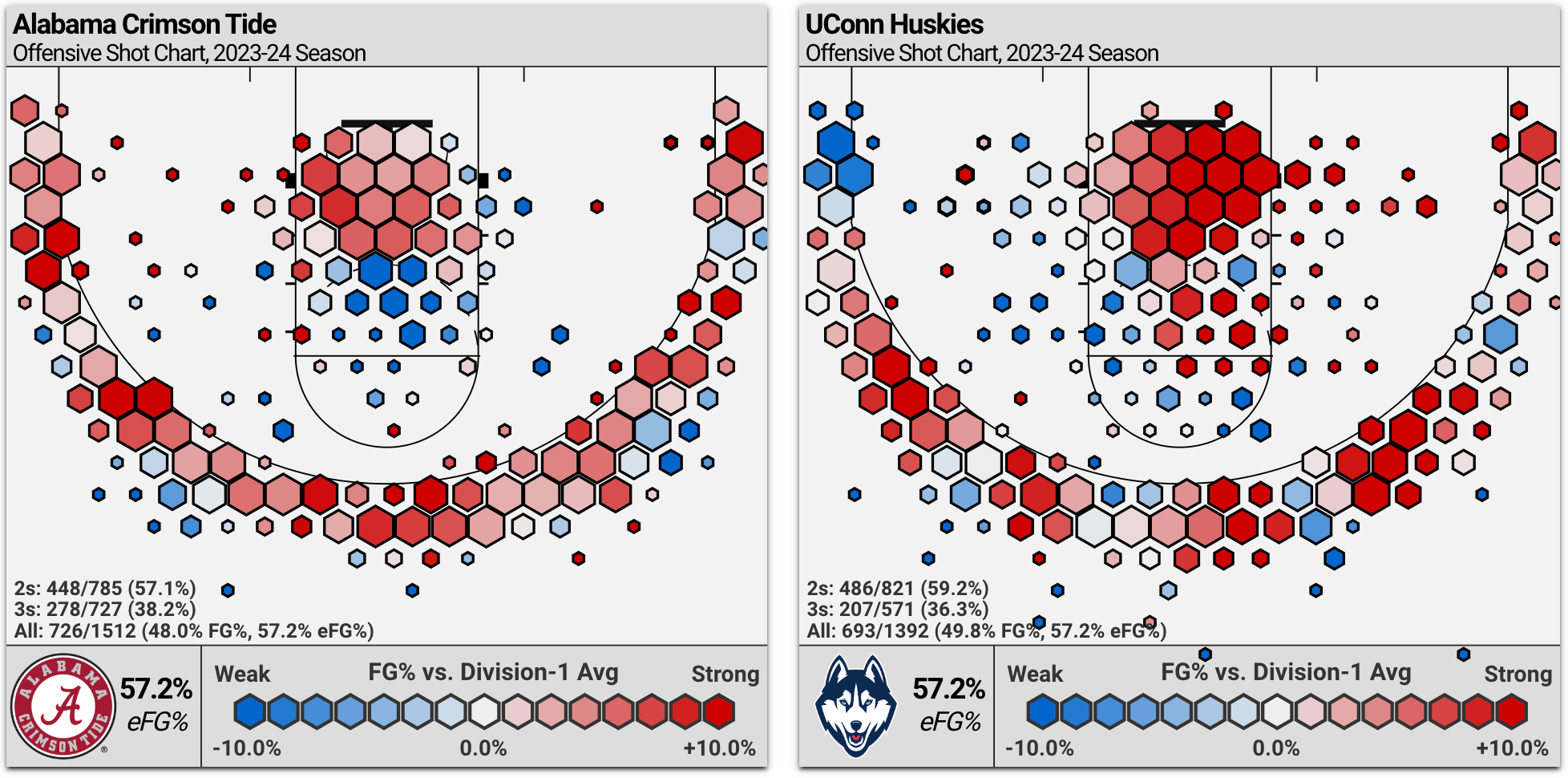
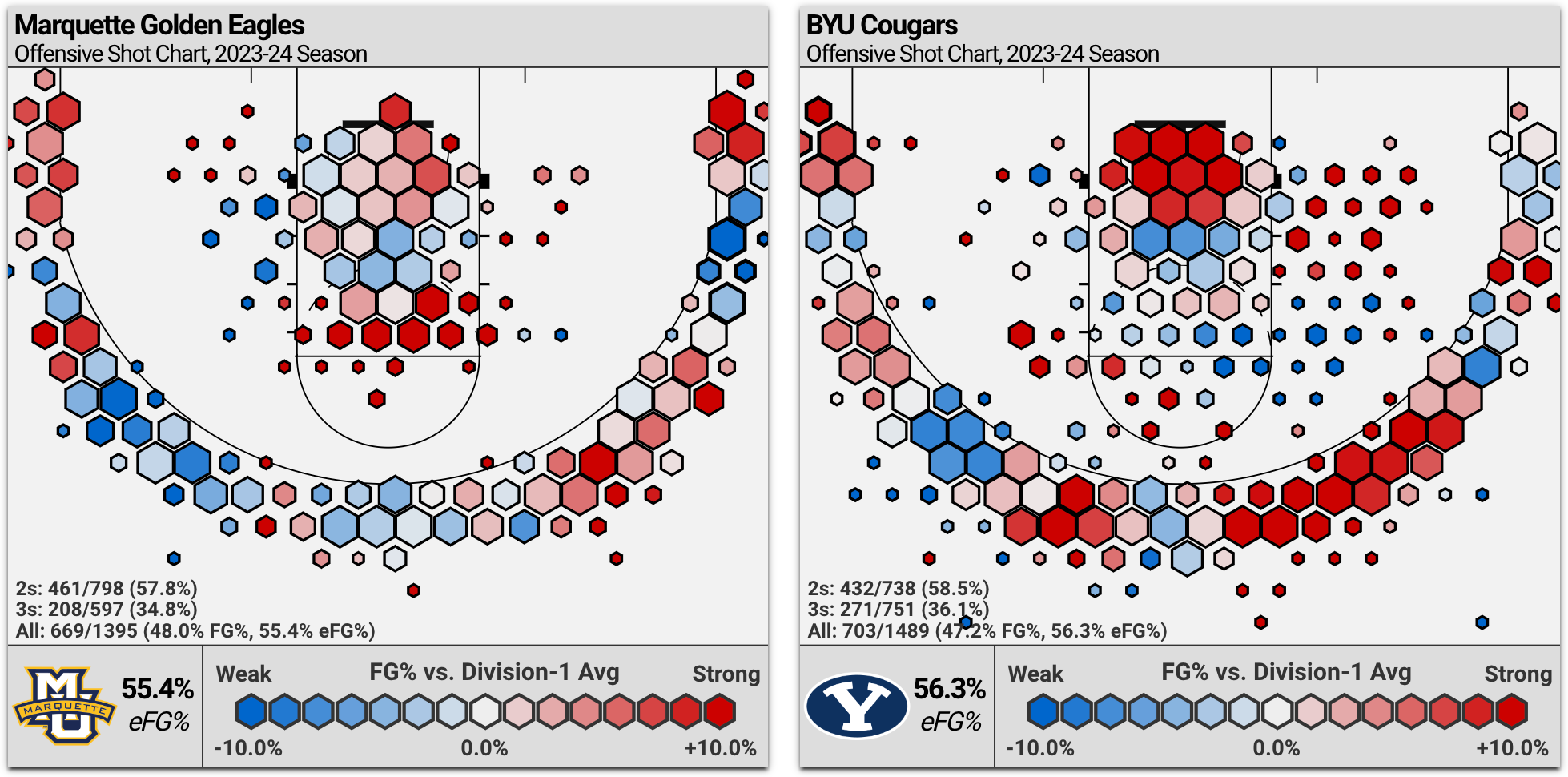
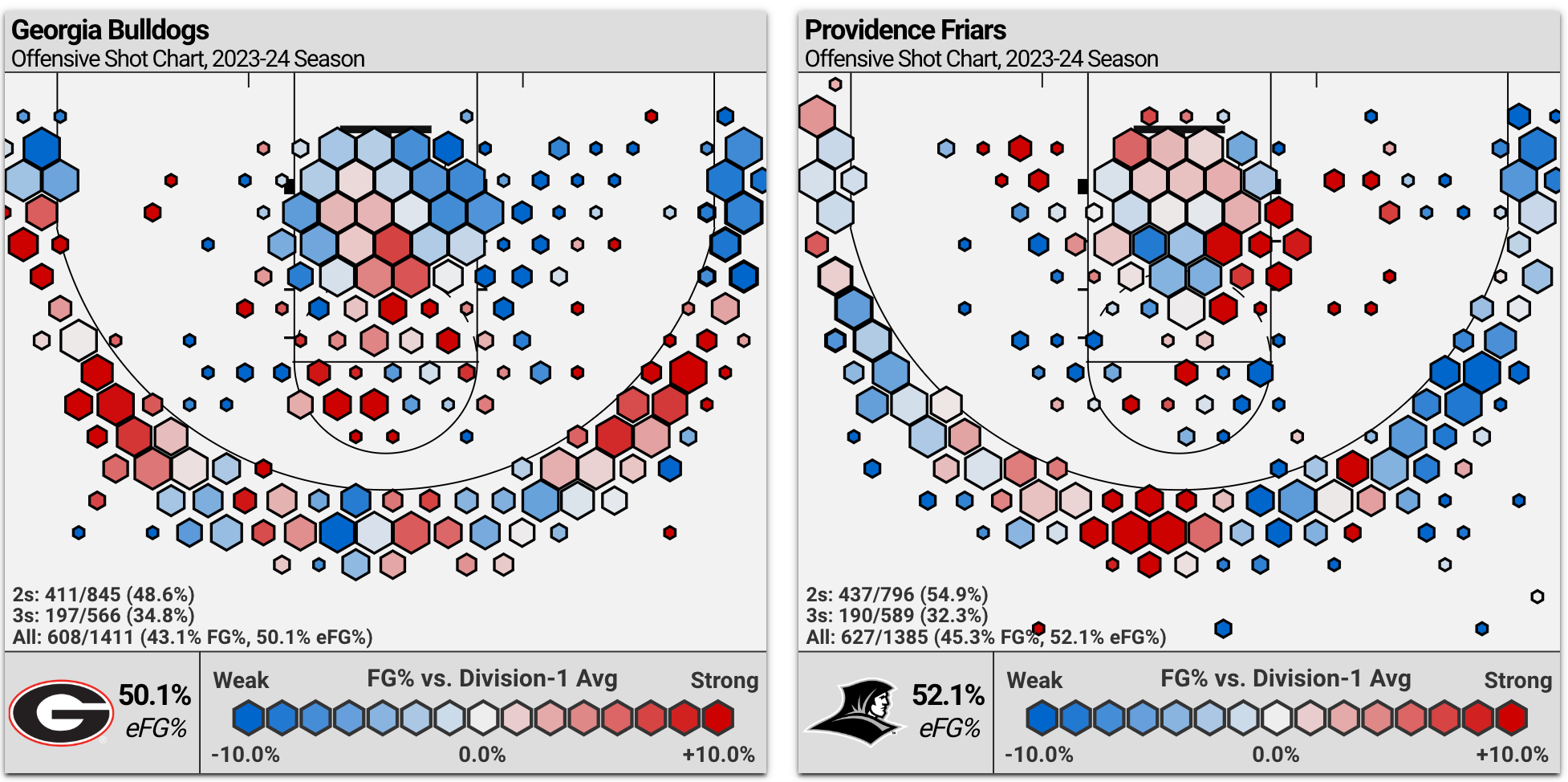
Here's the rub: Four of the six are ranked in the top 15 of KenPom.com and BartTorvik.com, but two are way off. Providence (55th at KenPom) is currently on the outside looking in of the NCAA Tournament picture. Georgia is 14-10 and below top-70 status in every mainstream metric.
So while it's a good math strategy, it's not a guarantee of anything at the high-major level. Across all of D-I, Canova ran the data and found "the correlation between team offensive rating and the percentage of a team's shots taken from the midrange is -0.352. This negative correlation is stronger than I anticipated, although the -0.352 aligns with the pattern observed in previous years (-0.287 last season, and -0.368 the year before that)."
I'm well aware most people reading this won't know what "-0.352" means. Canova said the "correlation suggests that, on a general level, teams taking a lower percentage of their shots from the midrange tend to have higher offensive ratings." But there are regular "exceptions to this trend across the 362 teams analyzed."
This scatterplot puts the correlation into some better perspective — courtesy of CBBAnalytics.com.
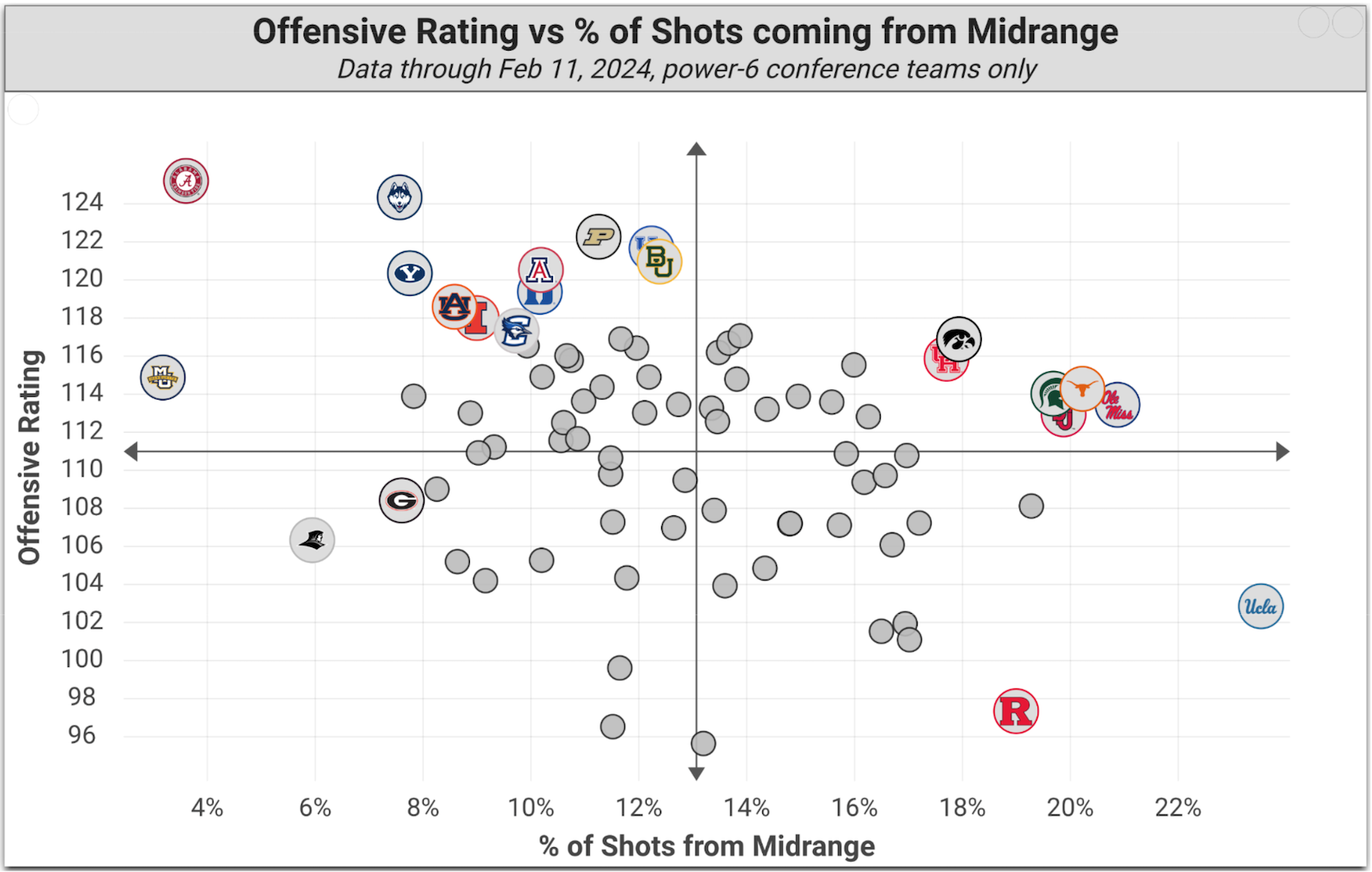
Providence and Georgia prove that abandoning midrange jumpers won't cure your offense. But being midrange-heavy is likely to sink your efficiency.
"You can shoot a high percentage of shots from the midrange and still have a decent offensive rating," Canova said, citing Houston, Iowa, Texas, Michigan State, etc. "With that said, it's very hard to be an elite offense shooting a high percentage of midrange shots."
A key stat: Every team scoring 117 points or more per 100 possessions (Alabama, UConn, BYU, Arizona, Purdue, Kentucky, Baylor, Duke, Auburn, Illinois, Creighton) is below the average in midrange attempts/frequency.
That's only a taste of CBB Analytics' toy chest. Some other sortable data on the site, hard to find elsewhere, includes:
- stats on charges drawn, and-1s, shooting fouls drawn
- assisted vs. unassisted shooting stats
- shooting stats by time on the shot clock
- team efficiency and shooting stats for different possession start types (following a turnover, made shot or missed shot)
I'm also a sucker for a stat with a catchy name, and Canova came up with a great one: Hakeem Percentage. It's the stat that shows the best combined blocks and steals percentage, in honor of Hakeem Olajuwon's unique defensive capabilities as a big. Here are the most efficient swatters + stealers so far this season.
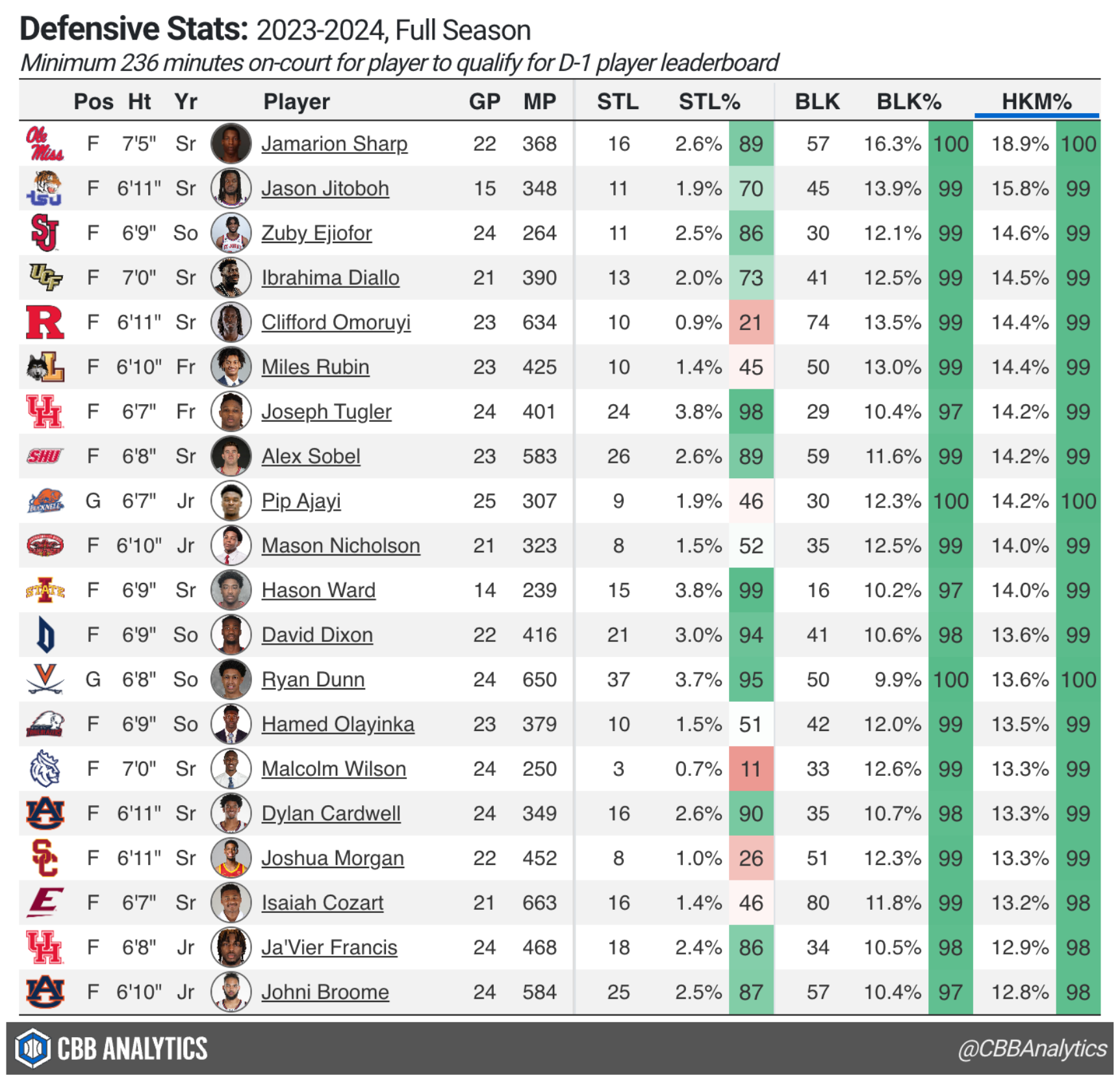
CBBAnalytics.com has a lot more, including color-coded shot charts and honeycomb maps for every player. You can lose an hour touring the site, easily. While it's been marketed primarily as a service for scouting and coaching staffs in its nascent years, it has already been opened up even more as an information gateway for enthusiastic basketball fans who want to discover the illuminating details beyond simple box scores and traditional statistics.
Indiana State's AP rankings gap fourth longest ever
Monday was a momentous day for the program most famous for counting Larry Bird as an alum. The Indiana State Sycamores (who real ones have known for weeks is a legit mid-major threat come March) finally cracked the AP Top 25 (23rd). The 22-3 Sycs are, wouldn't you know, ranked for the first time since Bird was in uniform, back when ISU had its memorable undefeated run to the 1979 national championship game. And so, this week ended the fourth-longest drought between AP poll appearances ever.
Longest gap between making the AP Top 25
Yrs Team From To
59 Colorado State 1954 2013
53 Butler 1949 2002
51 Portland 1959 2010
45 Indiana State 1979 2024
41 Rutgers 1979 2020
41 Northwestern 1969 2010
41 Penn State 1955 1996
Of the previous seven longest droughts, Colorado State, Rutgers and Penn State wound up having NCAA Tournament-worthy teams. The Sycamores are battling with Drake in a tremendous tussle atop the Missouri Valley. The two are so good, they're pacing toward giving the Valley a chance at having its second two-bid season since 2016.
@ me
The Court Report's weekly mailbag! Find me on X/Twitter or Bluesky and drop a Q anytime.
@MattNorlander Matt, do you know why over the past 3 weeks and what I believe is the rest of the season, the ACC, Big 12, Big East and SEC have scheduled no Thursday games?
— Pete LaVette (@PeteLaVette) February 8, 2024
TV inventory is cued up for these leagues to play their weekend games only on Saturdays, meaning they don't want the two-day turnaround from Thursday. The Big Ten always has Sunday matchups to spread it out (thus having Thursday games), and the Pac-12 has long done the Thursday/Saturday swing but ... we know that league's fate. None of the other four power leagues have Sunday schedules, though I expect that to change with conference bloat coming next season. More Sunday games is also better for getting better officials on both weekend days.
>>📬 Dude Diligence via Bluesky asks: Is this Chris Holtmann's last year at Ohio State?
There's conflicting opinions around the sport right now as to whether it will be. My guess is it will not. OSU (14-10) will win just enough and Gene Smith will hold off calls to fire Chris Holtmann as Smith prepares to retire in the late spring. Holtmann will enter 2024-25 needing to make the NCAAs to keep his job — and maybe win multiple games if/when he gets there.
Curious how many Syracuse, BC, Pitt, Louisville and ND fans wish they were going to MSG in NYC every March?
— Philip Tortora (@PhilipTortora) February 9, 2024
This is a rhetorical question in response to the ACC announcing that (rightfully) it's decided to hold 2025-29 league basketball tournaments in the state of North Carolina. (This year will be in Washington D.C.) A lot of basketball fans have helplessly watched as their programs lost relevance and juice in a trade-off for football money and ... not a whole hell of a lot else. I'd be furious if I was a Syracuse or Pitt fan at this point, but money is the solution and destruction and solution and destruction and solution and destruction to college sports, globally and locally.
>>📬 Jay McAnany via Bluesky asks: Is UConn the only solid lock as a 1-seed and how many teams are realistically in the running for the other three?
I am annoyingly litigious with the term "lock" as it pertains to NCAA Tournament forecasts. Some folks get wayyyyy too loose with the expression. Connecticut is by no means a No. 1 seed lock yet, but at the same time, it's extremely hard to see the Huskies playing themselves off the top line. My list of teams that I think, as of today, can still reasonably hope to be in the No. 1 seed conversation in a month: Purdue, UConn, Houston, Arizona, UNC, Tennessee, Iowa State, Marquette, Kansas, Alabama, Baylor, Duke. That's 12 teams. I'd be stunned if anyone outside of that group entered the conversation.
Norlander's news + nuggets
• One job vacancy is off the board. As had been expected for nearly a month, Charlotte promoted interim Aaron Fearne to the full-time gig Monday. Fearne pulled off the rare feat of unexpectedly getting a job (Ron Sanchez left in the summer and went back to Virginia) and then winning a promotion prior to March. The 15-8 49ers are a mover in the American.
• This you almost never see: The ASUN has suspended an official for the remainder of the season after he allegedly used a racial slur toward Jacksonville coach Jordan Mincy (in addition to making physical contact). Mincy was ejected minutes into Saturday's game.
• Sure, No. 6 Kansas got blitzed at Texas Tech on Monday, but at least it's got Allen Fieldhouse. The Jayhawks are a stupid-good 30-1 in their last 31 Big 12 home games.
• Myles Rice and a few others aside, it's been a second straight underwhelming season for freshmen across the board. Still, two guys have come on strong lately who will be key if their teams want to make the Sweet 16: Baylor center Yves Missi put up 19.0 points and 7.5 rebounds vs. ranked Texas Tech and ranked Kansas. South Carolina forward Collin Murray-Boyles became the third Gamecocks freshman in 32 years to score 30 points in a game; Murray-Boyles averaged 23.5 (on 78.6% shooting) plus 8.0 rebounds last week. No. 11 SC is riding seven straight SEC wins for the first time since 1996.
• More Gamecocks content you can use. We have a social media account dedicated to tracking South Carolina's win rate depending on Lamont Paris' choice of quarter-zip.
Vandy didn’t like us and they paid the price. pic.twitter.com/q425qRbqjf
— Lamont’s Quarterzip (@LPsQuarterzip) February 10, 2024
• Feel pretty comfortable and confident in saying that Clemson's two most recent wins (at UNC, at Syracuse) that moved the Tigers to 16-7 will propel the Tigers to the NCAA Tournament. By no means a lock, but this team will dance (and Brad Brownell will save his job once again).
• After a grueling first two months of the season, is UCLA going to enter March as a viable candidate to win the Pac-12 Tournament? Mick Cronin's team has won seven of its last eight. Only loss was by six at Zona. Hmmmm.
• Speaking of the Pac-12, I was extremely impressed with how Arizona responded Saturday (after needing three overtimes to beat Utah two nights prior) by going into Colorado and winning by 20 to sweep what I call the "ski weekend" road swing. Wildcats going to mess around and snag a top seed after all?
• This you have to see. Steve Peake of KSR pulled together 27 end-of-game possessions Kentucky has had in tie-or-win scenarios over nearly the past four years. Unbelievably, UK has gone 1 for 27 in that span. Here's every shot.
Kentucky has had 27 opportunities to tie or win the game since 2020.
— Steven Peake (@StevenPeakeKSR) February 11, 2024
They've made a shot one time.
That is kind of amazing. pic.twitter.com/Kd55RIw5UM













